Id Monsters: How Doom Was Created
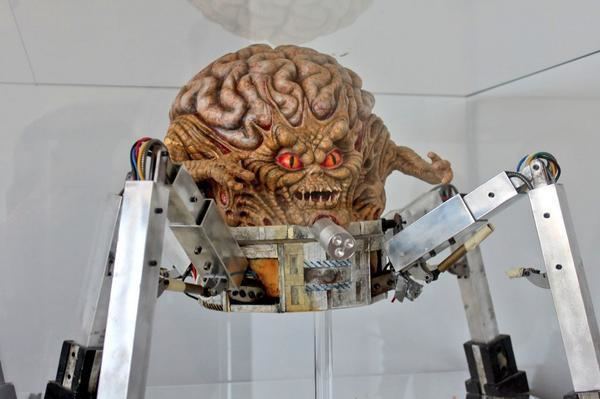
This retrospective from the very first (January 1994) issue of Game Developer magazine of the then modern games Id Software Doom and Wolfenstein 3D paints a unique portrait of the legendary developer, whose games laid the foundations of the FPS genre.
In an era when the implementation of all the stated capabilities often required 20 MB of memory, they managed to fit less than 4 MB. At a time when sound card compatibility was a major problem, they added support for Disney Sound Source to the demo. While many large gaming companies leisurely approached the idea of cross-platform development, it seemed quite natural to them. They wrote games; 30 or more employees would have to be developed, although their company consisted of only seven people. They are Id Software programmers, and what they do can permanently change the PC game industry.
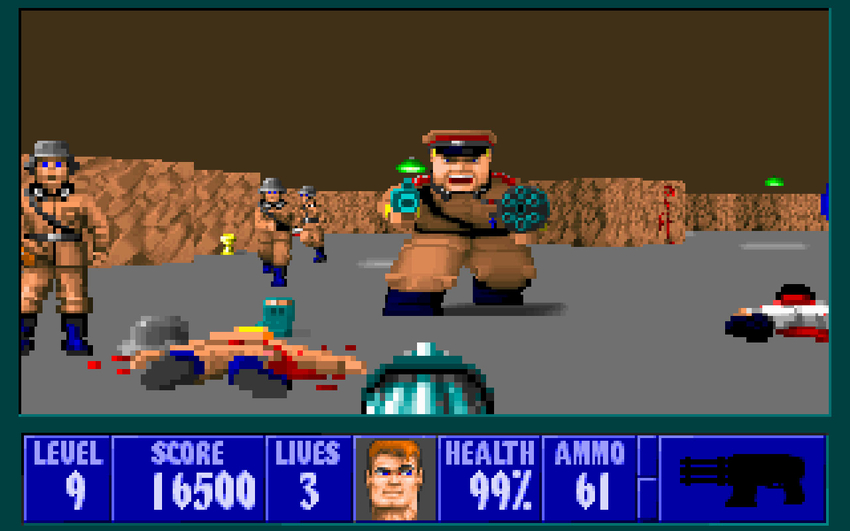
Wolfenstein 3d
In fact, the company brought her popularity of the previous game - Wolfenstein 3D . Wolfenstein 3D plot was as simple as a category B film: players with a fight make their way through the Nazi castle. But Wolfenstein 3D stood out from the rest of the games with its excellent use of bitmap images, digitized sound and amazing speed, creating the illusion of a three-dimensional world. Id used a technique called “texture mapping”, which, in combination with the assembler-rakesting engine, created playable 3D graphics on the 286, the weakest machine of that time.
But the most amazing aspect of Wolfenstein 3D is probably its distribution model. The game was shareware. In accordance with the time-tested technology of shareware, the first 10 levels of Wolfenstein 3D were free. The game's distributor, the shareware company Apogee, sold only additional levels. This allowed people to copy the first part of the game, which was in the public domain, and assess how well it works on their machines, and only then make the decision to purchase the entire game. The free file “teaser” spread like a virus and eventually filled the whole world - more than 20% of all orders for the game came from abroad.
')
It is precisely this that Id may have had the most influence on the PC gaming industry. By releasing a state-of-the-art shareware game, she was able to outrun the previous sales record for shareware games, delivered by yet another Id project, the Commander Keen series, more than five times. Having reached the level of 100,000 copies sold by the end of 1993, Id proved that games created at a professional level can be successfully distributed as shareware. To truly compare shareware with traditional sales, six months after Wolfenstein Id released a converted version of Wolfenstein called Spear of Destiny . By the end of 1993, both Spear of Destiny and Wolfenstein sold 100,000 copies each. At the same time, sales of Wolfenstein still continue to grow, and sales of Spear of Destiny have declined, because it has removed new games from the retail store shelves.
However, the revolutionary distribution model was not made by total sales, but by net profit. For example, for each copy of Spear of Destiny Id sold, it earns $ 8, sharing half the total revenue with FormGen's retail distributor. In the case of the Wolfenstein cartridge for SNES, it only gets about $ 2. But using the distribution system through shareware Id was able to get the full cost of the game minus the cost of materials and processing orders of the operator company. In the case of Wolfenstein , material costs were less than $ 5, and a full game cost $ 50. Although the company had to share revenue with Apogee, she gave her a share of the profit that any software company could envy.

Evolution Id
Id Software has come a long way, the modest beginning of which was laid in Shreveport, Louisiana. The main part of the future development team Id met at Softdisk, which released monthly game discs. One of the founders of Id, John Romero, was sent letters from fans, which he attached to the wall in his office. He didn’t particularly think about them, until one day, while reading an article about the shareware game Caverns of Kroz in a game magazine, he noticed a familiar address.
It turned out that Apogee President Scott Miller saw one of the games that Romero and his colleagues created for Softdisk, and wanted them to join his company distributing software through shareware. Knowing that all mail sent to Softdisk will open at the reception desk, he wrote to programmers with various names fake fan letters, which always ended with the words “write me at ...”. When John Romero saw the same address on the entire mail from the fans, I realized that he had not so many fans as he thought. But the only real fan will have a huge impact on his fate.
Miller saw the talent in the guys and wanted those who in the future would become the core of the Id development team to work with him. Scott handed Romero and his team a check for $ 2,000, and they wrote a paragraph with the idea of the game, which will be the first part of the Commander Keen trilogy. At this stage, John Romero, John Carmack and Adrian Carmack left Softdisk and organized Id Software, the distributor of which was Apogee. Having lived a bit in Madison, Wisconsin, the Id team moved to its current headquarters in Mesquite, Texas.
It is in this corner of the suburb of Dallas that Id Software has become truly independent. The company's founders: lead programmer John Carmack, project manager John Romero and graphic artist Adrian Carmack were joined by former Softdisk colleagues — Managing Director Jay Wilbur, creative director Tom Hall and graphic designer Kevin Cloud. They formed the main development team of Wolfenstein and Spear of Destiny, which upon completion of these projects reaped the benefits.
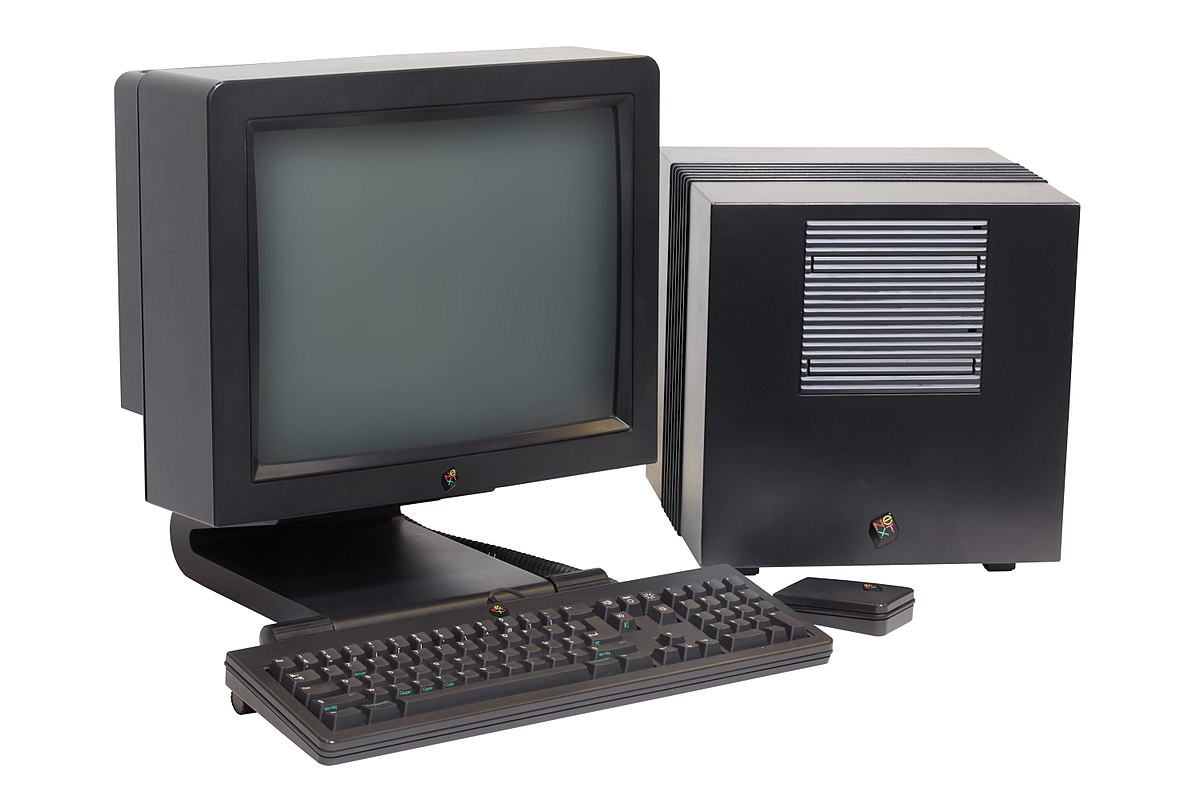
Id possessions
The main working environment of the Id is several PCs connected by a network (DOS runs on some of them). However, when it comes to programming, NeXTStep becomes the preferred working machine for the team. John Carmack never regretted that once he had to wade through Madison’s snow to buy a cubic NeXT. The creation of the level editor, written by Romero for Doom , took five man-months, but on any other operating system this would take much longer.
The Wolfenstein version for the Super Nintendo Entertainment System (SNES) was mainly developed on the NeXT machine, and Apple IIGS was used to compile and port code to ANSI C. For further development under SNES, Id planned to reconfigure the Free Software Foundation Assembler and the GNU C compiler to generate code 65816 on the NeXT machine, and use the ROM emulator card to download the code compiled on NeXTStep 486 directly into Nintendo SNES.
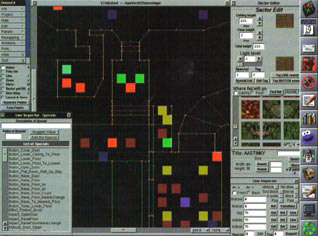
The figure above shows the DoomED level editor — a good example of what the Id in NeXTStep is capable of. It has the functionality of a simple CAD program and allows level designers to concentrate not on programming, but on level design. In DoomED, the level designer can arrange monsters and objects (multi-colored blocks on the screen) and, more importantly, change the walls, ceilings and floors of the game environment. The editor allows you to use bitmap images created by graphic artists, so the level designer can improvise without drawing the images yourself.
Although there is often speculation that Id uses a large amount of assembly code when developing, the main language is ANSI C. “Assembly language is almost dead,” says Carmack. “There are only two assembler procedures in Doom : one for stretching the columns vertically, the other for applying texture to the line horizontally. Everything else is written in C ".
Carmack suggests that if all the Doom code were written in assembler, and the programmer correctly managed the surplus of resources, the game would be only 15% faster. And although the main trace of reykasting in Wolfenstein is written in assembly language, Carmack says that thanks to the advanced algorithms, he could write Wolfenstein in C so that it runs faster.
Writing ANSI C code facilitates porting to other operating systems and recompilating code under DOS, and NeXTStep helps in getting rid of bugs in the development process. It seems to Carmack that in just a couple of days off he would be able to get Doom to work in a window on a Macintosh, but Id will not write the port itself. Id would like to work with adherents of various operating systems, and is considering creating Doom versions for Macintosh, OS / 2 and UNIX.
Core id
Two people from the core of the Id development team are the biggest fans of Id games and their toughest critics. Lead programmer John Carmack is considered the main reason for the technical superiority of games Id. Talking with him about the games he created almost plunges him into depression - he always emphasizes how much better they would be if he wrote them today. When the contractor whom Id hired to create the network drivers for Doom , did not cope with the work, as if nothing had happened, Carmack wrote the network driver and the next day made him work.
Unlike Carmack, with his eternal pessimism about his past creations, project specialist John Romero is the biggest Id game fan you could meet. When he plays the latest beta, mouthing his own sound effects to compensate for the temporary lack of sound in the game, his enthusiasm infects. It is this perfect combination of a hard-nosed programmer playing games and a hard-nosed gamer programming them that makes Id games so wonderful.
True to his nature, John Carmack was already disillusioned with Wolfenstein at the time of its public release. His game engine was created in the first month of the six-month development cycle, and by the time the first copy of Wolfenstein was transmitted between modems in America, he knew that he could make it better. While the rest of the Id development team worked hard to complete Wolfenstein , Carmack was writing a game engine that would later be licensed by Raven to create the game Shadowcaster.
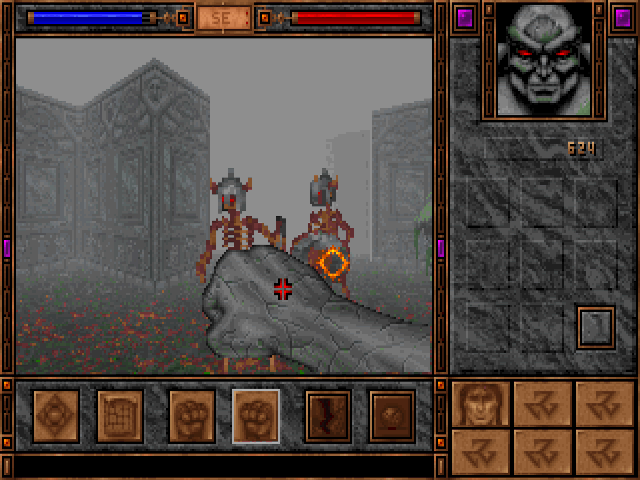
Shadowcaster game
This game engine supported a multipoint perspective and allowed objects to be above the player. Based on improvements made to the Raven engine, a new game (tentatively titled “Green and Pissed” (“Green and Evil”)) was to be created. But in the process of developing what was supposed to be a Doom game, Id Software broke off relations with two partners who were with it from the very beginning.
At the beginning of the development of Doom , it was decided which direction Id games should take. This decision led to the fact that the founder Tom Hall left Id Software. Carmack and Romero felt that Hall’s creativity came into conflict with the gameplay. As a creative director, Hall insisted on the integrity of the story and sought to add a story to the game. As Romero said later, "If the game is good, then the story itself is not needed."
“A game designer should not create a world in which a player is only a small part of it,” echoes Carmack. "The player is the boss, your task is to entertain him." In the midst of similar disputes and other creative differences, Hall left Id to become the project manager at Apogee.
Move on
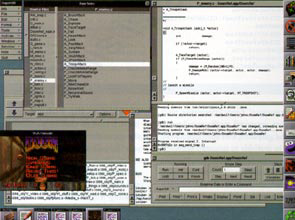
Recovering after Hall’s departure, Id crystallized her design ideology. Id's mission is to take technology at the forefront of progress and turn it into exciting games. The plot, or lack of it, in Doom is a good example. It consists only of a very vague idea of hitting the space station and descending to hell. Doom , and possibly all other future Id games, includes a minimally possible plot, which is enough to set the atmosphere and insert references to popular culture, mainly to category B films. Perhaps Carmack put it the best: we put a dangerous position in the player and allow the instincts to beat and run. ”
Another break of old connections was that Id took over the spread of Doom , refusing the services of Apogee. Although initially Id employees were pleased with the work with Apogee, which opened the door to the world of shareware games, the company believed that Apogee did not have enough resources to cope with the wave of telephone orders that would accompany the release of Doom . An ironic twist: after Id hired Digital Magnetics to handle telephone orders, Apogee realized that Id was right about its capabilities and as a result also entered into an agreement with Digital Magnetics. Id continues to work with Apogee on current projects, such as Wolfenstein II , which Apogee will develop on its own with a slightly improved Wolfenstein engine. Id still recommends Apogee to potential game programmers as a good starting point for starting a career.
Gaining experience in working with the engine for Raven, Carmack began work on Doom . The Raven engine was much more powerful than that of Wolfenstein . He could render inclined floors, apply textures to any part of the cube (in Wolfenstein, the cube was necessarily the same from all sides), allowed using different textures for the ceiling and creating walls at an angle not only 90 degrees. Unfortunately, the technologies used in the Raven engine were too complex, so for work on Doom, Carmack had to start from scratch.
Three versions later, Carmack finally got a game engine, the performance of which corresponded to his expectations. The engine was optimized for fast machines: it broke the card into small sectors and put them in such a way that you could use the internal cache 486. In the finished Doom engine there is a medium detail mode that doubles the width of pixels horizontally and triples the speed of the game on slower machines . Another important addition to the Doom engine was that all objects had physical characteristics: weight, impulse, and even sound. For example, in Doom, bullets were physical projectiles, unlike Wolfenstein , where they were just calculations. Improved AI procedures allowed monsters to interact with each other, and light sources gave a greater sense of depth.
Doom Advanced Features
One of the functions that appeared in the engine from the very beginning was the multiplayer mode. Id added this feature, making a start for the future. Doom developers felt that multiplayer games would become increasingly popular, and the Internet and other types of commercial networks are beginning to be used more actively on home computers.
Although Id expected less than 10% of players to take advantage of Doom , up to four people can participate in a game on the Novell IPX network. Id developers thought it was important to start working on multiplayer games right now to gain experience by the time they become critical in development.
However, after adding a multiplayer, other difficulties appeared. For example, checking the scope of AI monsters slowed down the game, because they were performed for each player. Another problem with AI procedures was that the monsters hunted some players, but completely ignored others. These shortcomings were eliminated, but a minor problem remained, which had to be left in the game.
Players' sprites were drawn with the same weapon, which in single player mode was not a particular problem. But in multiplayer, players could not understand which of the seven different types of weapons their opponents are holding. To inform the players about this, it would be necessary to draw seven complete sets of character sprites, but the designers decided that it was not so important.
The graphics for Wolfenstein were entirely drawn by Adrian Carmack, but when working on Doom , the Id team understood that they needed help. She benefited from the support of professional model designer Gregor Punchatsa and created a system that made it easy to digitize the results of his work.
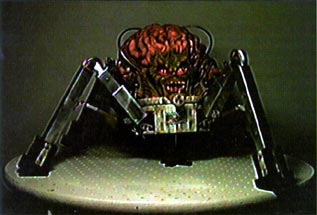
The models were placed on a turntable, where they were attached to the base. There were eight pins on the table, indicating the eight points of view that the game engine needed to render the creatures. Then the models were animated frame by frame: the model shifted, and then turned onto each of the viewpoints used by the engine. Images were digitized by a video camera connected to a NeXT machine. After capturing each frame, it was imported over the network to a PC with the installed Dpaint tools from Electronic Arts, in which the photographic source was converted to game resolution. Images were drawn at full brightness, and the game engine changes the contrast depending on the light source.

Typically, Id neglected sound effects during the development process, in part because there was no sound programmer on the staff. The sound quality for Doom will be better than in Wolfenstein , because it was recorded at a sampling frequency of not 7, but 11 kHz. Id thinks that 16-bit sound is a brute force for Doom and for any other action-based game, given the effort involved, disk space and processor resources. Id developers were ready to implement support for Roland Sound Canvas and most popular sound cards, but they began to receive angry letters from supporters of the Gravis UltraSound card. The company believed that it would take too much time and effort to support UltraSound, but the sound contractor Id cut the Gravis code and UltraSound support appeared in the finished game.
No matter how good the Wolfenstein gameplay is, there is always room to grow. Id used the experience from Wolfenstein to make Doom better. For example, the secret doors in Wolfenstein were often indistinguishable from the walls around them, so the only way to find them was to check each wall on the level. In Doom, all secret doors have some noticeable feature that distinguishes them from the environment. More weapons have been added to the game, and each type has its own unique twist. Unfortunately, the biggest cannon, the BFG 9000, had to be loosened, because it was so complex that with every shot the game started to slow down a lot.
Another improvement was the automatic mapping mode, which allows players to sort out the intricate corridors in a two-dimensional perspective from a top view. In the automap mode, one restriction is intentionally added - monsters are not visible on it. This restriction was added during the playtest, because when testers switched to autocard mode, they preferred to stay in it, rather than play on a three-dimensional game screen. “A game is not a task that needs to be solved effectively, but an experience that needs to be experienced,” says John Carmack.
Cracking a Doom Cradle
One aspect of Wolfenstein that was not covered by the developers from Id was the emergence of a whole hacker industry that was trying to crack the Id code. Perhaps the reason was that Wolfenstein was distributed via modems, and this stimulated people to hack map and bitmap editors, and sometimes create fully modified games based on a shareware version with ten levels. Apogee argued that all these "mutations" of the game harm sales, because people, in fact, received much more for free than the first 10 free levels.
Id employees looked at it differently; they did not object and believed that people had the right to use the game as it seemed interesting to them. They planned to do the same with Doom and even revealed some technical specifications. But this time the game will check the checksum to make sure that it has not been changed. If it has been changed, a message will appear on the screen about the non-original version and information about where to buy the original.
Alpha and beta leaks poisoned Id's life from its very first days, and Doom was no exception. In the early stages of developing Wolfenstein , the authors had the idea to hold a competition: the one who finds the secret room, hidden somewhere on one of the levels, should receive $ 10,000. But the first person to call was a pirate who found the secret even at the beta testing stage, which was why he had to give up the prize.

Doom in version 0.2
Early in the development of Doom , the alpha version of the game was so widely distributed that people called technical support to find out why the sound did not work on their machine. Of course, he did not work, because he was not in the game yet. The most unpleasant story happened with the alpha version of the Wolfenstein cartridge for SNES. The game was sent to just a few game magazine editors, and yet it somehow fell into the hands of a Hawaiian pirate who produced cartridges for the black market. To try to protect against such situations, Id created a beta policy: the games were password protected and the distribution of beta copies was carefully controlled.
For Id, foreign markets were important, and the developers made great efforts to increase the availability of the game. All symbols were created from graphics, not from fonts, so that Id could transfer graphic files for translation to foreign distributors, and the game itself did not need to be recompiled. Sales abroad accounted for approximately 20% of Wolfenstein sales, and now Id expects that, thanks to a good distribution contract abroad, foreign orders will account for a third of Doom's sales. An unexpected obstacle that caused various rumors was the problems that had arisen for Wolfenstein in Germany. Id said that Wolfenstein was banned there, but not because of Nazi symbols, but because of the level of violence, and the company expects that the same restrictions will be imposed on Doom .
Despite the fact that Id receives an average of five calls per month from venture capitalists offering to make the company public and large, Id Software tends to remain private and small. Id developers believe that team size is ideal for working on one or two projects. Growth plan Id includes working with other small developers and licensors. This plan corresponds to what happened to Wolfenstein - Id developed a new technology and demonstrated it in the game, and then licensed the technology to other software companies that used the code and Id tools to create games. In the case of Wolfenstein, Id licensed JAM Productions technology, which created Blake Stone, and Apogee to create Wolfenstein II .
Id plans to develop relationships with other companies, such as Cygnus Studios. Cygnus has developed several games for Apogee that Id liked. Therefore, Id invited Cygnus to move to Texas and work with the Id team. Cygnus is currently working on a cyberpunk role-playing game that uses the Doom engine and all the tools Id [approx. Trans .: judging by the description, this is the game Strife, which completed and published Rogue Entertainment] . After completing the game Cygnus, Id will be its shareware distributor.
After the release of the shareware version, Doom Id will begin work on the commercial version of Doom in the same way that she did Spear of Destiny after Wolfenstein . The commercial version of Doom will take advantage of the company's experience in the shareware market and will fix all the unexpected problems that arise in the shareware version. And this is another nice aspect of shareware distribution. If problems arise due to the variety of equipment on the PC market, they can be instantly eliminated and released a new revision, which the next users will be able to download from the Id electronic bulletin boards.
Future doom
The next project was to be Doom for SNES, but in the process of working on Wolfenstein for Nintendo, plans changed. In the development of Wolfenstein under SNES there were no technical problems, Nintendo itself put obstacles. Nintendo forced Id to remove Nazi symbols from the game and replace German Shepherds with huge rats, but there was nothing complicated about that. Over the next couple of months, Nintendo found fault with every detail and made the Id team so angry that it abandoned its further development under SNES.
Now Id is looking towards the Atari Jaguar console. Initially, the Id developers were delighted with it and were going to start developing for this console after completing the Doom version for SNES. Id sure Atari will sell more than 500,000 Jaguar consoles. Nintendo, Id Atari.

Doom - SNES
, . , . , . Id , , , , .
Source: https://habr.com/ru/post/432956/
All Articles